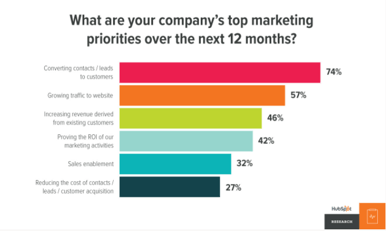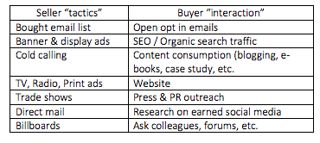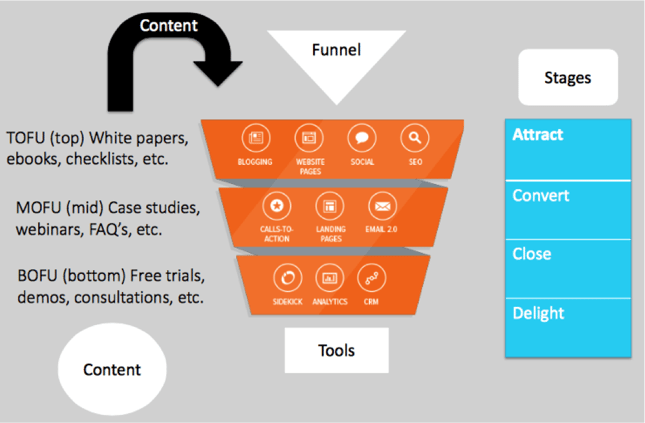The reality is that a sales prospect will find you when they’re ready to buy something; no matter how much effort you put into chasing them.
But Sales and Marketing are critical to a business’s success. Failing to get through to your target audience can mean a lack of leads to fill the sales pipeline and a decline in sales and revenue.
Traditionally outbound marketing has been the typical approach for many years to generate leads, with businesses pushing out information to contacts whether they asked for it or not. Which is why the phrase “interruption marketing” was coined.
Today’s Marketing & Sales Priorities
According to HubSpot’s State of Inbound report, marketers today are focused on converting the visitors they attract into leads and customers; growing website traffic, followed by increasing revenue from existing customers. Sales need to sell more, improve the efficiency of the sales funnel and reduce the length of the sales cycle.
Below is a graph from the HubSpot State of Inbound 2016 report, listing the top marketing priorities over the next 12 months from respondents.

Outbound vs. Inbound Behaviour
Outbound marketing does have benefits, especially for bigger companies that may have the budget to cover a larger number of tactics to drive traffic and brand awareness through greater reach and distribution. Outbound organisations tend to focus more on sales enablement and less on leads and traffic growth compared to a more inbound focused one.
But changes in buyer behaviour are making sales and marketing adopt a strategy to target a buyers’ specific needs and preferences throughout the buying cycle, a buyer-centric approach using more digital resources.
The inbound methodology in principle tries to attract rather than distract an audience and grow attention organically by generating website traffic using educational and informative content that visitors are searching for. This audience has already therefore expressed an interest in what you have to offer – by visiting your website, may be downloading content or opening an email you have sent that they opted in for. The inbound strategy is more of a “pull”, as opposed to the outbound marketing’s “push” tactics.
What Is Outbound Marketing?
Outbound marketing involves distributing your marketing message to as large an audience as possible, not necessarily at the time or place that is pertinent to their needs. By pushing a “one way” message there is no way that you can be sure where your prospect is in their buying cycle. Are they just starting to look, do they even know they have a problem or are they already far along the sales cycle and you are adding no value to the conversation?
There is often in my mind a mis-match between how sellers communicate and buyers source and digest content. Typically sellers rely on outbound tactics to get their sales messages across, whereas buyers are using online methods to do self-research to educate themselves adopting the principles of inbound methodology.
If you think of many of the current sales tactics they probably fall into the following categories; email, direct mail, conferences, trade shows, cold calling, on-line banner / display ads, etc. And from a marketing perspective it would be print ads, billboards and outdoor advertising, TV & Radio, brochures, etc. With so many messages thrust into our daily lives, it’s no wonder that consumers are filtering out the noise and your message.
When you compare the outbound tactics versus the buyer interaction preferences you can see that there is a risk of a mis-match (see below).

The costs associated with outbound marketing are often out of reach for smaller businesses and inbound marketing tends to be less expensive as a cost of customer acquisition. One advantage of inbound marketing is that it opens up a two-way communication, listening and engaging with the buyer, thinking of ways to help rather than closing a sale at the first opportunity.
When you consider the behaviour today of a B2B buyer, we know that they can be difficult to reach through traditional marketing methods and prefer to educate themselves using primarily online sources. Recent research from Demand Gen B2B Buyers Survey Report 2016 found that the main sources of information that buyers reference were taken primarily from; web search activities, vendor websites and insights from peers (see chart below).

Again looking at the research from Demand Gen B2B Buyers Survey Report 2016 the most important factor in evaluating a B2B vendor is that they show evidence of being able to solve a pain point (see chart below).
To be in a position to know what that particular pain point is, you need to have researched your buyer, created a buyer persona profile to know what their pain is, and understand how to apply your solution through which channel and level of interaction. This is an approach that cannot be done effectively using an outbound strategy because it becomes a numbers game, using an expensive marketing model with multiple messages and complexities where you hope if you send out enough communications at some point it will hit a target.

The Value Of The Sales Funnel
There is of course a desire on the part of marketing to grow brand awareness and increase website traffic. Which is why the sales funnel is widest at the top, and narrows towards the bottom as the visitors who are qualified and ready to buy become much smaller. Most companies think of a high volume of website traffic as being a positive metric and invest a lot in these top of the funnel activities to attract sales leads or visitors during their research phase.
The concept of the sales funnel (see grid below) is to show the buying journey (from Awareness to Decision) that your B2B sales prospects theoretically take as they go from discovering their problem right through to shortlisting vendors and making a purchase.

A sales funnel aids visualisation of what content needs to be delivered to which buyer persona at what particular stage in their buying journey. The sales funnel (see below) will be different for each business, but we can think in common terms of top of the funnel (TOFU), middle (MOFU) and bottom (BOFU).

It’s Time to Transform Your Marketing
With the Internet and the social media revolution there has been pressure applied to sellers to become more aligned with the buyer. Today buyers do not have to rely only on salespeople or corporate sources to learn about products and services, this information is readily available online.
Inbound marketing is a methodology that sets out to draw website visitors and sales leads to you, rather than distract customers with messages that come at the wrong time.
- 47 percent of buyers view three to five pieces of content before engaging with a sales rep. (Demand Gen)
- 51 percent of B2B buyers rely on content to research their buying decisions. (Demand Gen)
With so many touch points now in the buying process the sales cycle is becoming longer and more complicated. Budgets are more restrictive, more vendor options to consider, more stakeholders and a risk averse culture all contribute to a challenging buying process.
The Internet and access to cheaper technology have levelled the playing field in today’s competitive market place, making it a great time to take advantage of low-cost, high-impact inbound marketing strategies.
The 9x Golden Rules For Inbound Marketing
The purpose of inbound sales and marketing is to make people aware of your business by creating and sharing relevant content that your audience finds educational and informative as they search for solutions. So to make sure you have a road map on how to achieve sales success use our 9x rules to get you started:
- Develop your buyer’s personas; use this in your strategic marketing approach
- Define your online value proposition (what you are selling)
- Focus on a particular digital customer touch point that you can influence
- Know what, how, where & which keywords your target audience use for search
- Optimise the rest of your digital communications around your persona and their digital habits
- Develop your content marketing approach to focus on how to solve the buyer’s personas pains
- When you get a visitor to your website – ask yourself, are you ready to convert?
- Know which keywords your competitors are using, match, rank and improve your performance
- Set yourself a specific goal, traffic is good but you need visitors to convert and buy!
Take Away
Good content is relevant, timely, wows your audience and is distributed in a smart way; so it’s available when and where your prospects are searching for it.
Some of the ways that using an inbound methodology could benefit your company fuelled by content marketing and used effectively by your sales and marketing resources can be seen in the chart below:

And if that was not enough, you can always contact us for help on how to use content marketing to get your lead generation engine started.

